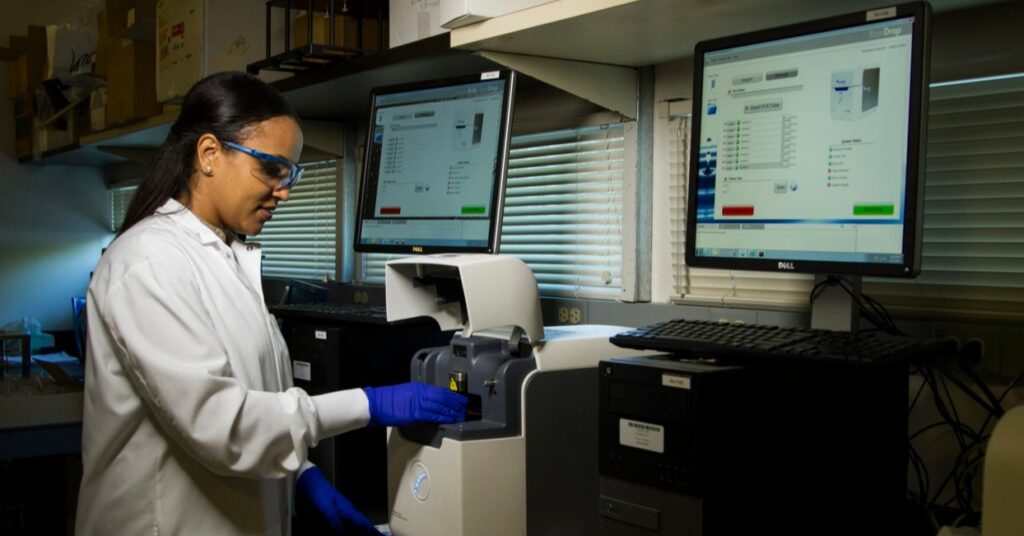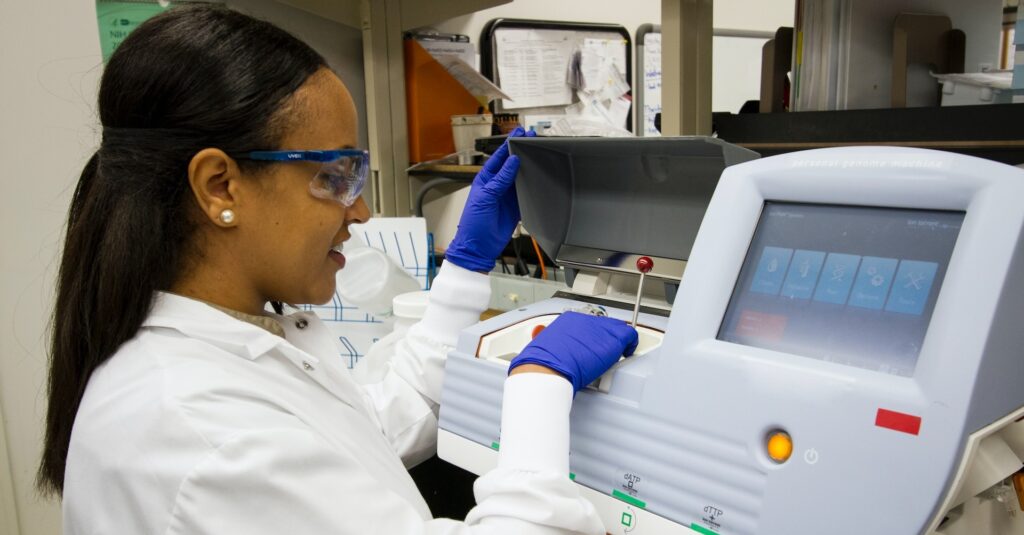
What Is the Epidemiological Triangle?
The epidemiological triad or triangle is an organized methodology used [...]

The healthcare industry generates thousands of exabytes of data each year. To put that in perspective, one exabyte equals one billion gigabytes. A little more perspective: an x-ray image typically requires 20 megabytes (0.02 gigabytes) of storage. One exabyte is approximately 50 billion x-ray images.
Needless to say, that’s a lot of data that can be leveraged to improve outcomes, optimize treatments, customize care, reduce costs, and make medicine better. Unfortunately, the vast majority of that data is hard to access and hard to analyze. There’s not only a lot of it; it also comes from a lot of different sources, including electronic medical records, connected medical devices, and drug trials.
That’s where healthcare data analysts come in. These professionals have the knowledge and skills to sift through the tsunami of information coming out of provider networks, hospitals, labs, insurance companies, and public health agencies. They find the data, organize it, interpret it, and turn it into actionable insights.
Some say this job sits at the intersection of business and healthcare, and it’s true that health data analysis can be used to make money. But data analytics in medicine also saves lives. The work of health data analysts can reduce medical mistakes, help providers make more accurate diagnoses, and reduce the impact of pandemics.
Given the importance of data analytics in healthcare, you might assume that health data analysts are paid quite well. The reality, however, is that while you won’t starve in this role, you probably won’t get rich, either. How much can you actually earn in this role? In this article about the average healthcare data analyst salary, we attempt to answer that question by addressing these questions:
healthcare data analysts are responsible for collecting, managing, and analyzing healthcare data and finding answers to questions related to business operations, medicine, or both. Questions like:
Using statistics to identify trends in everything from treatment efficacy to operational costs is a big part of the job. That’s because providers, healthcare facilities, and insurance companies are increasingly looking for ways to use data to drive decision-making.
Depending on what kinds of questions they’re trying to answer, a healthcare data analyst might use data sourced from:
healthcare data analysts do more than just use data to find answers to questions and solutions to problems. They’re also responsible for presenting their findings to executives and other stakeholders. In some cases, they also have to create custom dashboards that automate reporting and make it easier for stakeholders to find answers in data themselves.
Data analysts who work in healthcare go by many titles:
Whether these titles actually represent different kinds of health data analysts is up for debate. All healthcare data analysts analyze information and use similar skills to do it. They all have to be well-versed in the complex web of rules and regulations governing patient privacy and medical records keeping. And yet, healthcare analysts working in different settings often tackle very different kinds of problems.
Some healthcare data analysts work for hospitals and other providers. They spend their days looking at sanitized electronic health records to identify patient patterns that can be used to customize care, predict which patients are at risk of dying, decrease readmission, or improve patient outcomes. The same data can be used to prevent costly or deadly human error by alerting doctors and nurses to potential drug interactions or dangerous dosages. Hospitals and healthcare networks also employ health data analysts to help control costs.
Other healthcare data analysts work for insurance companies, looking for ways to reduce costs or improve efficiency. By looking at subscriber claims and outcomes, along with drug pricing data, they can identify opportunities to create education campaigns to reduce claims for preventable diseases, find the best and most cost-effective providers, and determine which subscribers need which types of diagnostic tests.
Other healthcare data analysts work in the public health sphere, looking at metrics like lab tests, claims data, and social factors with the goal of disease prevention. They use predictive analytics to identify the patients and populations most at-risk of specific conditions. Public health professionals can design targeted outreach campaigns and work with providers to improve patient outcomes in areas where people are most likely to get sick. Health data analysts can also play a role in closing care gaps, predicting and intervening before epidemics can become pandemics, and getting public health funding where it needs to go.
Clinical healthcare data analysts also join teams of researchers that run clinical trials to determine whether new medicines and medical devices are effective and safe. An analyst might manage and monitor information collected related to side effects and efficacy. They might also design specialized reporting or analysis software created just for the trial.
It’s not clear which of the above analysts earn the most. Average salaries can differ by tens of thousands of dollars when you sort by title (more on this below), but pay is determined by so many factors, including location, highest level of education, experience, what the market will support, and, in research jobs, grants and federal funding.
More healthcare data analysts have bachelor’s degrees than master’s degrees or other degrees—possibly because having an advanced degree doesn’t seem to offer much of a boost to earning potential. Some health data analysts earn a bachelor’s in health informatics or Bachelor of Science in Health Information Management, but it’s also possible to launch a career in health data analytics with a data analytics degree or a Bachelor of Science in Healthcare Administration with a data analytics concentration. Southern Oregon University offers one.
Health informatics and health information management degree programs at the bachelor’s degree level often focus more on data storage and management than on data analysis. That means aspiring healthcare data analysts will usually choose a data analytics minor or spend significant time outside of school picking up skills related to:
Only about 27 percent of health data analysts have master’s degrees. Still, pursuing an advanced degree isn’t a bad idea if you have a passion for health data analysis. Health informatics and health information management at the master’s degree level are more likely to devote class time to data analytics theory and techniques, but there are also dedicated healthcare data analytics and data science master’s degrees at schools like:
If your goal is to earn more money, opt for a healthcare data science degree. It can help you transition into a better-paying position in analytics.
The average healthcare data analyst salary is about $73,500, according to PayScale. That’s a comfortable salary in many parts of the US, though health data analysts in states like California and New York might feel the pinch. However, complicating matters is the fact that the professionals who do this work can go by many other titles. ZipRecruiter tracks salary information for many of them. According to their data:
Make sure your search parameters are fairly broad when you’re job hunting, so you don’t miss out on higher-paying opportunities.
According to sites like PayScale and ZipRecruiter, entry-level healthcare data analysts with less than five years of experience typically earn somewhere between $56,000 and $61,000. How far that will go will depend on where an analyst lives, but in general, that’s relatively high for newly-minted professionals who are just starting out. Earning more than that in this role right after graduation may be possible if you can rack up some professional experience while you’re still in school. That will usually mean completing one or more data analytics internships in healthcare or health sciences settings.
The answer depends on the source. PayScale reports that experienced healthcare data analysts earn about $75,000, which doesn’t sound like a lot for a professional with 20+ years of data analytics under their belt. With that much experience, however, a health data analyst should be able to apply for senior healthcare data analyst positions, which tend to pay more. The senior health data analyst salary is more than $80,000—and in some parts of the country, professionals in this role can earn close to $135,000.
The main professional certification for healthcare data analysts is the Certified Health Data Analyst (CHDA) offered by the American Health Information Management Association (AHIMA). The credentialing exam is open to any analyst with:
According to the AHIMA, having the CHDA credential is a salary booster. In a salary report released by the organization, CHDA holders earned an average salary of $92,100 in 2019, placing them among the top-earning certificate holders in health information.
In this role, earning more tends to be all about experience, certification, and skills. You should consider getting your CHDA credential, and possibly also the AHIMA’s Certified in healthcare Privacy and Security credential, as well. Having one or more of the following skills can also increase your earning potential:
You can also earn more by working in one of the following cities:
Just keep the cost of living in mind because a big paycheck doesn’t always go further when you live in a major metro area.
Finally, you can earn more in this role by working in particular settings. The AHIMA salary report included information about earnings by job setting. According to the findings, health data analysts can boost their earning potential by looking for work in:
Health data analysts are increasingly in demand as healthcare providers, and healthcare networks look for professionals who can collect, monitor, analyze, report on, and predict outcomes with data. A Burning Glass report on data analysts in healthcare found that as of 2016, insurance companies, providers, hospitals, and even colleges and universities were hiring more data analysts than ever before and demand was still growing.
It’s not surprising. The volume of data created by the healthcare industry is only going to go up. Companies and organizations across the healthcare space will need qualified people to deal with it. Whether pay will go up as demand increases remains to be seen, but there’s one surefire way for healthcare data analysts to boost their earnings… by transitioning out of health data analytics and into health data science. It’s a much more technical role, but it’s also a much higher-paid one.
(Updated on January 10, 2024)
Questions or feedback? Email editor@noodle.com

The epidemiological triad or triangle is an organized methodology used [...]

A family nurse practitioner (FNP) provides comprehensive primary health care [...]

FNPs practice in a broad range of health care settings. [...]

Some epidemiologists assist pharmaceutical companies in developing safer medicines. Some [...]

A Bachelor of Science in Nursing (BSN) is a four-year [...]
Categorized as: Health Informatics & Sciences, Nursing & Healthcare